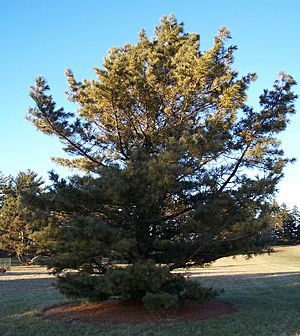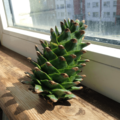Pinus koraiensis facts for kids
Quick facts for kids Pinus koraiensis |
|
|---|---|
 |
|
| Cultivated at Morton Arboretum | |
| Conservation status | |
| Scientific classification | |
| Genus: |
Pinus
|
| Species: |
koraiensis
|
The Pinus koraiensis is a type of pine tree often called the Korean pine. It grows naturally in eastern Asia. You can find it in Korea, northeastern China, Mongolia, the temperate rainforests of the Russian Far East, and central Japan. In the northern areas, it grows on mountains about 600 to 900 meters (2,000 to 3,000 feet) high. Further south, like in Japan, it grows even higher, from 2,000 to 2,600 meters (6,600 to 8,500 feet) up. Another common name for it is the Chinese pinenut.
Contents
What the Korean Pine Looks Like
The Korean pine is part of the white pine group. In its natural home, it can grow very tall, sometimes up to 30 meters (100 feet)! If it's grown in a garden, it might reach about 15 meters (50 feet).
Young Korean pines have a pyramid shape with branches that point upwards. Older trees have branches that spread out more, sometimes reaching the ground. The bark is gray or brownish and flakes off, showing a reddish color underneath.
Its branches have bundles of five blue-green needles. Each needle can be up to 11.5 centimeters (4.5 inches) long. The tree also grows brown cones that can be up to 15 centimeters (6 inches) long.
How We Use Korean Pine
The nuts from the Korean pine are edible, meaning you can eat them! They are sold in stores, especially in Europe and the United States, as pine nuts. The oil from these nuts is used to make things like lubricants and soap. The tree also provides turpentine resin and tannin.
People also plant the Korean pine as an ornamental tree in gardens and parks. It can grow well in different types of soil and does fine in cities. It's also good at handling very cold winters. There are different types of Korean pine, called cultivars. Some have blue-colored needles, like 'Glauca' and 'Silveray'. Others, like 'Winton', have a wider shape.
The wood of the Korean pine is very useful for building. It's light, has straight grains, and is easy to work with. It's used for many products, including telephone poles, railroad ties, bridges, boats, plywood, flooring, furniture, sports equipment, and musical instruments. It can also be easily turned into chips for particle board or pulp for paper.
Conservation Efforts
Because the wood is so valuable, wild Korean pine forests have been over-harvested. This means too many trees were cut down, which harms the forest ecosystems where they grow.
The Siberian tiger lives in these pine forests. Protecting the Korean pine helps to protect the tigers too, as it's part of their home.
Another interesting fact is that the spotted nutcracker (a type of bird) helps the Korean pine. These birds collect the seeds and help spread them around, which is important for the tree's reproduction.
Gallery
-
Trunk cross section
See also
 In Spanish: Pino de Corea para niños
In Spanish: Pino de Corea para niños













